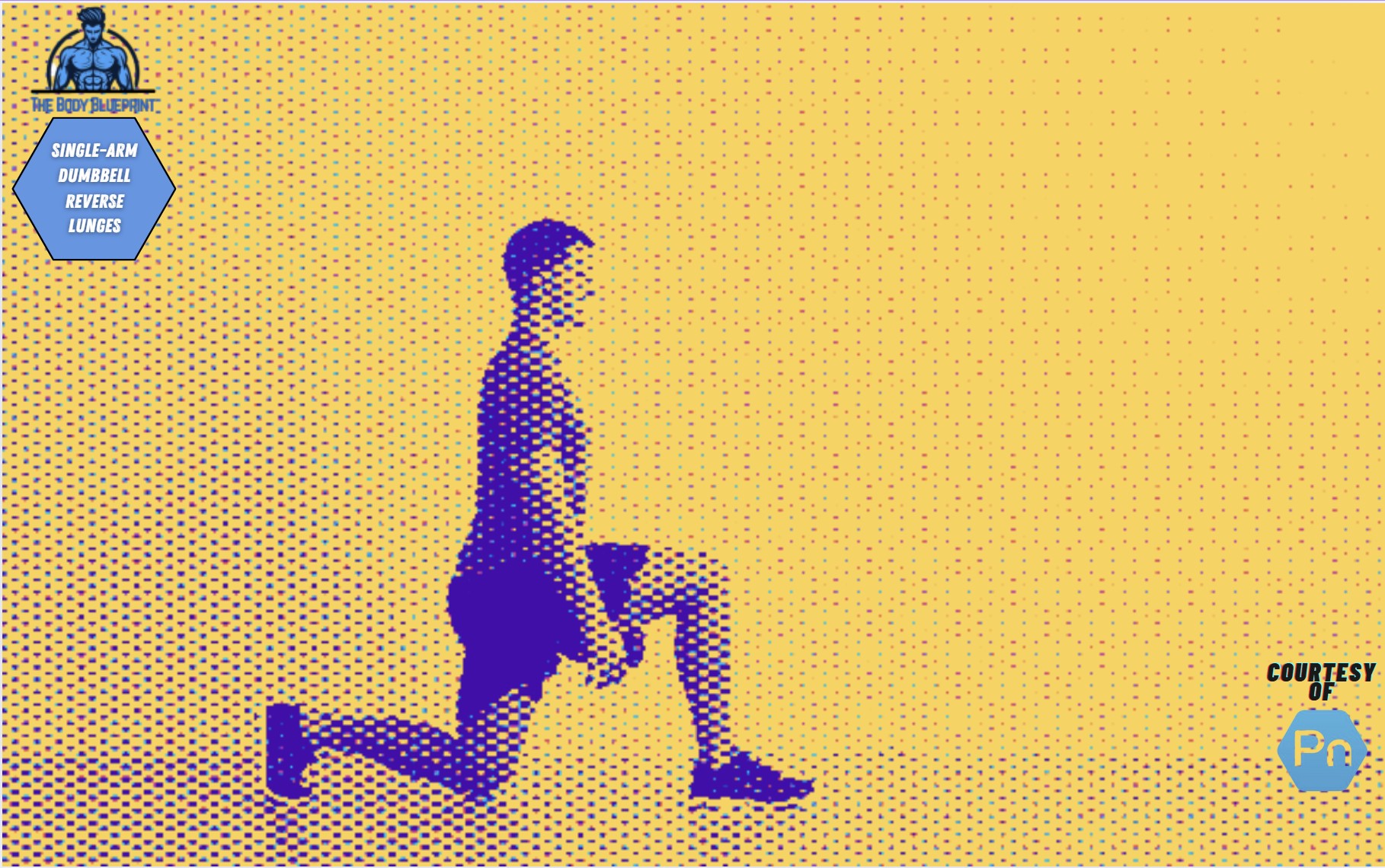When it comes to sculpting legs that not only look strong but are strong, single-arm dumbbell reverse lunges are the unsung hero of leg day. This move doesn’t just hit your quads, glutes, and hamstrings—it’s a full-body balance challenge that humbles even seasoned lifters. Let’s dive into why this exercise deserves a spot in your routine, how to do it right, and the surprising ways it benefits your entire body.
What Are Single-Arm Dumbbell Reverse Lunges?
This exercise is a unilateral lunge variation where you hold a dumbbell in one hand while stepping backward into a lunge. The imbalance caused by the single-arm hold forces your core to stabilize, making it more than just a lower-body movement.
| Key Details | Single-Arm Dumbbell Reverse Lunge |
|---|---|
| Primary Muscles Worked | Quads, glutes, hamstrings |
| Secondary Muscles Worked | Core, calves, hip stabilizers |
| Difficulty Level | Intermediate to Advanced |
| Required Equipment | Dumbbell |
| Key Benefit | Improves balance, unilateral strength |
Why Single-Arm Dumbbell Reverse Lunges Are a Game-Changer
Balancing Strength Asymmetries
Unilateral exercises like this one target each side of your body individually, exposing and correcting strength imbalances. If you’ve ever noticed one leg overpowering the other during squats, this move is your fix.
Core Stability Under Fire
Holding the dumbbell in one hand challenges your core to resist rotational forces. Think of it as a hidden ab workout masquerading as a lunge.
Functional Athleticism
This move mimics real-world movements, like stepping backward to dodge something or shifting weight while pivoting. It’s the kind of strength that pays off outside the gym.
Performing Single-Arm Dumbbell Reverse Lunges (With Precision)
Step-by-Step Breakdown
- Setup:
- Stand tall with your feet hip-width apart.
- Hold a dumbbell in one hand at your side; let the other arm relax.
- Execution:
- Step one leg backward into a lunge, keeping your torso upright.
- Lower your body until your front thigh is parallel to the floor and your back knee hovers just above it.
- Drive through the heel of your front foot to return to standing.
- Switch Sides:
- Complete all reps on one side before switching to the other hand and leg.
Form Tips to Dominate This Move
- Keep your chest lifted and shoulders square throughout.
- Brace your core to resist any twisting motion caused by the uneven weight.
- Use a mirror to ensure your knee tracks over your toes without caving inward.
| Common Mistakes | Fix It Like This |
|---|---|
| Knee caves inward | Focus on pressing through the heel |
| Back rounds forward | Engage your core and keep chest up |
| Dumbbell swings excessively | Slow down and control the descent |
Muscles Worked and Why It Matters
This isn’t just a leg exercise—it’s a full-body multitasker.
Primary Movers
- Quadriceps: Power through the movement and stabilize the knee.
- Glutes: Fire up to drive you back to standing.
- Hamstrings: Assist with hip extension and knee stabilization.
Support Squad
- Core: Stabilizes your spine and resists rotation.
- Calves: Help maintain balance, especially during the push-off phase.
How to Level Up Your Single-Arm Dumbbell Reverse Lunges
Ready to spice it up? Here’s how to push your limits:
- Add Tempo Work: Slow down the lowering phase (3-4 seconds) to increase time under tension.
- Use a Heavier Dumbbell: But only if your form stays rock solid.
- Elevate Your Front Foot: Increases range of motion for deeper muscle activation.
Benefits of Single-Arm Dumbbell Reverse Lunges
Better Stability and Balance
Training with an uneven load demands more from your stabilizers, which means better balance overall.
Boosts Athletic Performance
Whether you’re sprinting, jumping, or cutting, unilateral strength translates directly to explosive power.
Injury Prevention
By addressing asymmetries and improving mobility, this move helps prevent the overuse injuries common in bilateral lifts.
Common Mistakes and How to Avoid Them
- Mistake #1: Rushing the movement.
- Fix: Slow it down to maintain control and focus on form.
- Mistake #2: Neglecting the non-working side.
- Fix: Engage your free arm to counterbalance and stabilize.
- Mistake #3: Letting your front knee collapse inward.
- Fix: Actively push your knee outward as you descend.
Comparison: Reverse Lunges vs. Single-Arm Dumbbell Reverse Lunges
| Feature | Reverse Lunges | Single-Arm Variation |
|---|---|---|
| Core Activation | Moderate | High |
| Balance Challenge | Moderate | High |
| Muscle Engagement | Lower body only | Full-body |
| Difficulty Level | Beginner-Friendly | Intermediate to Advanced |
Integrating Single-Arm Dumbbell Reverse Lunges into Your Routine
Programming Tips
- Frequency: 1-2 times per week.
- Reps and Sets: 3-4 sets of 8-12 reps per side.
- Pair It With: Upper-body pulls (e.g., dumbbell rows) for a balanced workout.
Sample Workout
| Exercise | Sets | Reps |
|---|---|---|
| Single-Arm Dumbbell Reverse Lunges | 3 | 10/side |
| Pull-Ups | 3 | 8-12 |
| Dumbbell Bench Press | 3 | 8-10 |
| Plank with Dumbbell Drag | 3 | 30 sec |
FAQs: Your Burning Questions Answered
Can Beginners Do This Exercise?
Absolutely! Start with a lighter dumbbell or no weight until you master the movement.
What Weight Should I Use?
Choose a dumbbell heavy enough to challenge you by the last few reps but light enough to maintain form.
Are Single-Arm Reverse Lunges Better Than Regular Reverse Lunges?
For core stability and unilateral strength? Yes. But both variations have their place in a well-rounded program.
Single-arm dumbbell reverse lunges might seem simple, but they pack a punch in terms of strength, stability, and athletic performance. Add them to your arsenal, and you’ll feel (and see) the difference in no time.

